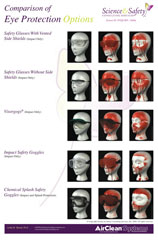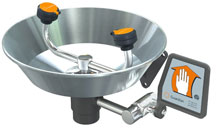



Find all of your laboratory and workplace safety supplies at Safety Emporium!
 CAS number |
 Glossary Index |
 Catharsis |
| MSDS Topics |
Free Sites | FAQ's | Regulations | Glossary | Software | Suppliers |
| Books | Forum | Poll | Fun stuff | Quiz | Store | |
| Understand your MSDS with the MS-Demystifier | Search ALL our MSDS info | |||||
A cataract is a partial or complete opacity (cloudiness) of one or both eyes. This usually occurs in the lens or capsule and can impair (interfere with) vision to the point of blindness.

Ensure workers understand what eye protection is really all about with safety posters from Safety Emporium.
The incidence of cataracts increases with age. The cause of cataracts is not often known, however certain diseases such as diabetes are associated with cataracts. Overexposure to the sun (UV radiation), smoking, hot work environments (such as furnaces or glassblowing), pesticide exposure, certain chemicals, as well as ionizing radiation can also increase the risk.
Cataracts can be treated with corrective lenses, medication and/or surgery. Replacement of the lens with an artificial lens is successful in approximately 98% of cases.
NOTE: We may collect a share of sales or other compensation from the links in the following list:
Prolonged (chronic) exposure to certain chemicals can cause cataract formation in the eyes, or a condition closely resembling cataracts. Examples of such chemicals include naphthlene, bendiocarb (a pesticide), potassium isocyanate, ethylene oxide, dinitrophenols, ammonium hydroxide, and osmium tetraoxide among others. The damage that these substances cause to your eyes may or may not be reversible.
Section 11 (toxicological information) of the Safety Data Sheet will explain such hazards. If you must use substances that can produce eye damage or cataracts, be sure to use proper administrative and engineering controls to prevent the release of the substances into your work environment.
Good ventilation is very important. Personal protective equipment (PPE) such as safety glasses and goggles offer no significant protection from fumes or vapors, so do not rely on these to protect your eyes! Air-supplying or PAPR respirators with full face masks are a good alternative, but simple dust masks or HEPA filters are ineffective against chemical fumes and vapors.

Safety Emporium carries all kinds of eye/face washes, safety showers, drench hoses and more.
See also: conjunctivitis, eye wash, sclera.
Additional definitions from Google and OneLook.
Entry last updated: Monday, June 13, 2022. This page is copyright 2000-2025 by ILPI. Unauthorized duplication or posting on other web sites is expressly prohibited. Send suggestions, comments, and new entry desires (include the URL if applicable) to us by email.
Disclaimer: The information contained herein is believed to be true and accurate, however ILPI makes no guarantees concerning the veracity of any statement. Use of any information on this page is at the reader's own risk. ILPI strongly encourages the reader to consult the appropriate local, state and federal agencies concerning the matters discussed herein.